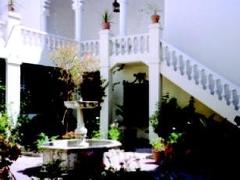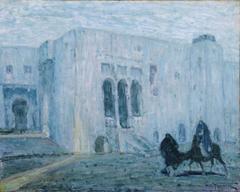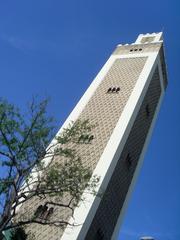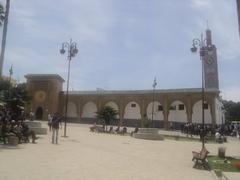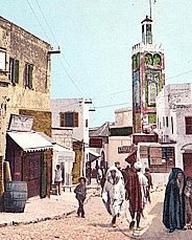
Tangier Cathedral: Visiting Hours, Tickets, and Historical Sites Guide
Date: 04/07/2025
Introduction
Tangier Cathedral—officially named the Cathedral of the Immaculate Conception and the Holy Spirit, and often called the Spanish Cathedral—stands as a testament to Tangier’s rich multicultural heritage and architectural diversity. Located in the bustling Ville Nouvelle district, this neo-Gothic and modernist monument, completed in the mid-20th century during Tangier’s International Zone era, elegantly blends European ecclesiastical traditions with Moroccan motifs. Today, the cathedral serves both as an active Catholic place of worship and as a distinctive symbol of Tangier’s cosmopolitan past, where Christian, Muslim, and Jewish communities have long coexisted.
This detailed guide covers the cathedral’s origins, architectural highlights, practical visitor information—including opening hours and tickets—accessibility, nearby attractions, and expert tips for making the most of your visit. Whether you are a history enthusiast, architecture lover, or simply curious about Tangier’s layered heritage, this article provides everything you need to plan a rewarding visit.
For further information and updates, consult resources such as Secret Attractions, Infinite Morocco, and visitsights.com.
Table of Contents
- Introduction
- Origins and Construction
- Architectural Style and Features
- Visiting Hours and Ticket Information
- Accessibility and Visitor Guidelines
- Historical and Cultural Significance
- Modern Role and Community Impact
- Preservation Efforts
- Special Events and Services
- Nearby Attractions and Suggested Itineraries
- Visitor Tips and Etiquette
- Frequently Asked Questions (FAQ)
- Conclusion
- References and Useful Links
Origins and Construction
Tangier Cathedral was commissioned by the Spanish Catholic community during the unique period when Tangier operated as an International Zone (1923–1956). The foundation stone was laid in 1948, with the cathedral’s completion in 1961. Its construction represented Spain’s cultural and religious investment in North Africa during a time of shifting colonial dynamics (Secret Attractions). Built outside the ancient medina, the cathedral reflects Tangier’s rapid urban development and modernization in the mid-20th century.
Architectural Style and Features
Exterior Architecture
The cathedral’s architecture is a striking fusion of neo-Gothic and modernist styles, rare for a city dominated by Islamic and Moorish designs. Its symmetrical façade features pointed arches and a soaring bell tower, while subtle Moroccan motifs are woven into the stonework and decorative details (Archnet). The whitewashed exterior harmonizes with Tangier’s Mediterranean palette yet asserts its unique identity.
Interior Highlights
Inside, visitors are welcomed by a spacious nave flanked by side aisles, with ribbed vaults enhancing both the structure and the acoustics. The vibrant stained glass windows—many attributed to Spanish artists—blend Christian iconography with Moroccan geometric patterns, casting colorful light across the sanctuary (Infinite Morocco). The ornate altarpiece, dedicated to the Immaculate Conception, and the side chapels with statues of saints further enrich the sacred atmosphere.
Artistic Embellishments
- Stained Glass: The apse features panes by Arcadi Blasco, complemented by abstract works from José María de Labra, creating a captivating interplay of color and light.
- Mosaic and Tilework: Subtle geometric tiles and mosaic patterns echo Moroccan zellij traditions.
- Woodwork: European and North African influences appear in the carved pews and choir stalls.
Lighting and Acoustics
Natural light floods the interior through stained glass during the day, while evening services are illuminated by chandeliers and sconces. The cathedral’s excellent acoustics make it a favored venue for sacred music concerts.
Visiting Hours and Ticket Information
- Opening Hours: Tangier Cathedral is generally open daily from 9:00 AM to 6:00 PM. Hours may vary during religious holidays and special events. It is advisable to check locally for the most current schedule (visitsights.com).
- Tickets & Admission: Entry is free for all visitors. Donations are welcomed to support the cathedral’s maintenance.
- Guided Tours: Available by arrangement through local tourism offices or at the cathedral. Tours deepen understanding of the building’s history and art.
- Special Events: The cathedral occasionally hosts art exhibitions, concerts, and interfaith events, particularly during major Christian festivals.
Accessibility and Visitor Guidelines
- Wheelchair Access: The main entrance and public areas are wheelchair accessible, though some interior sections (such as the bell tower) require stairs.
- Dress Code: Modest attire covering shoulders and knees is recommended. Hats should be removed inside the sanctuary.
- Conduct: Maintain silence and respectful behavior, especially during services. Photography is allowed in most areas but restricted during Mass or in certain sections.
- Safety: The area is safe and well-patrolled, but visitors should observe standard caution and secure personal belongings (passaportenobolso.com).
Historical and Cultural Significance
Tangier Cathedral epitomizes the city’s tradition of religious pluralism and cosmopolitanism. Built during the International Zone era, it served as a spiritual and cultural hub for the Spanish Catholic community amid a diverse urban landscape that included mosques, synagogues, and Protestant churches (Rough Guides; Britannica). After Moroccan independence in 1956, the cathedral transitioned from a colonial emblem to the seat of the Archdiocese of Tangier, continuing its legacy as a monument to multicultural coexistence.
Modern Role and Community Impact
Today, the cathedral remains active, hosting regular Mass (mainly in Spanish) and special services during major Christian holidays. Its open-door policy welcomes tourists, scholars, and architecture enthusiasts, while its tranquil gardens and spacious nave provide respite from the city’s bustle. The cathedral also plays a role in fostering interfaith dialogue and cultural exchange (moroccanscene.com).
Preservation Efforts
The declining local Catholic population has posed challenges for preservation. Nevertheless, collaborative initiatives involving the Catholic Church, Moroccan authorities, and international organizations have enabled ongoing restoration and maintenance efforts (Blue Door Cuisine). These projects ensure that the cathedral remains a vital part of Tangier’s cultural and spiritual landscape.
Special Events and Services
- Mass: Held Sundays and major feast days, typically in Spanish, with occasional French or English services.
- Festivals: Christmas, Easter, and other significant events draw larger congregations and visitors.
- Cultural Events: Art exhibitions and sacred music performances are hosted periodically. Check event schedules via local tourism resources or the Archdiocese (archidiocesetanger.org).
Nearby Attractions and Suggested Itineraries
Combine your cathedral visit with these nearby sites for a comprehensive Tangier experience:
- Grand Socco: A lively square connecting the medina and Ville Nouvelle.
- Sidi Bou Abib Mosque: Known for its colorful tilework.
- Kasbah and Kasbah Museum: Offers panoramic city views and historical insights (malika-in-morocco.com).
- American Legation Museum: A unique U.S. National Historic Landmark (malika-in-morocco.com).
- St. Andrew’s Anglican Church: Another testament to Tangier’s religious diversity.
A suggested itinerary: morning at the cathedral, stroll through the medina, lunch at a local café, and afternoon visits to the Kasbah and museums.
Visitor Tips and Etiquette
- Language: Arabic and French are widely spoken; Spanish is common at the cathedral. Some staff understand basic English.
- Best Time to Visit: Early mornings and late afternoons are quieter. Avoid attending during Mass unless participating (travelmoroccotoday.com).
- Photography: Discreet, no-flash photography is permitted in most areas; always be respectful during services.
- Amenities: Numerous cafés and shops are located nearby.
Frequently Asked Questions (FAQ)
Q: What are the cathedral’s opening hours?
A: Generally, 9:00 AM to 6:00 PM daily, though hours may vary during services or special events (visitsights.com).
Q: Is there an entrance fee or ticket required?
A: No, entry is free for individual visitors; donations are appreciated.
Q: Are guided tours available?
A: Yes, through local agencies or the cathedral, especially during high tourist seasons.
Q: Is Tangier Cathedral wheelchair accessible?
A: The main entrance and public areas are accessible; some sections like the bell tower are not.
Q: Can I take photographs inside the cathedral?
A: Yes, except during Mass or in restricted areas; avoid flash and tripods.
Conclusion
Tangier Cathedral is both a stunning architectural landmark and a living symbol of the city’s multicultural heritage. Its neo-Gothic and modernist features, enriched by dazzling stained glass and subtle Moroccan motifs, offer a unique window into Tangier’s cosmopolitan past. Open daily with free admission, the cathedral invites visitors to explore its spiritual and artistic treasures, attend services, and discover nearby historical sites. By following the practical tips in this guide, you’ll enjoy an enriching and respectful experience at one of Tangier’s most significant monuments.
For up-to-date visitor information, guided tour options, and cultural event schedules, check local tourism websites or download the Audiala app for curated audio guides and travel tips.
References and Useful Links
- Secret Attractions: Tangier Hidden Historical Sites
- Infinite Morocco: What to Visit in Tangier
- Archnet: Tangier Cathedral
- Archdiocese of Tangier
- Visit Morocco: Tangier
- visitsights.com: Tangier Sightseeing Tours
- Moroccan Scene: Tangier City Guide
- Malika in Morocco: The Ultimate Travel Guide to Tangier
- La Belle Seville: Tangier Travel Guide
- Passaporte no Bolso: What to Do in Tangier?
- Travel Morocco Today: Best Time to Visit Tangier
- Rough Guides: Tangier
- Britannica: Tangier, Morocco
- Blue Door Cuisine: Historical Facts about Tangier


